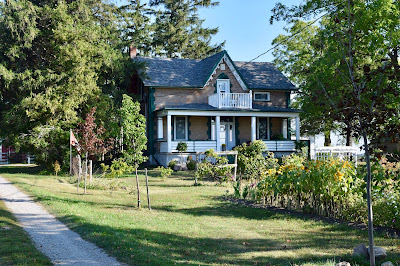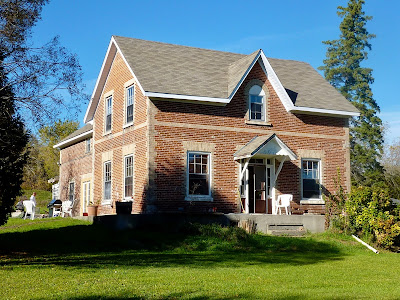 |
| Near St. Marys, Ontario |
A bit of good news for those concerned about our rural heritage.
The provincial government is closing a loophole that allows farmhouses to be demolished without the need to obtain a demolition permit. A “proposed change” to Ontario’s Building Code (OBC) would finally fix this. [1]
As background, the OBC distinguishes between a “building” and a “farm building.” “Farm building” is defined as “all or part of a building
(a) that does not contain any area used for residential occupancy,
(b) that is associated with and located on land devoted to the practice of farming, and
(c) that is used essentially for the housing of equipment or livestock or the production, storage or processing of agricultural and horticultural produce or feeds.” [2]
The quintessential “farm building” is of course the barn.
The problem arises because of some sloppy drafting way-back-when — or was it a deliberate policy choice? The OBC says that, “for the demolition of a building located on a farm”, you are exempt from the near-universal requirement for a demolition permit under the Building Code Act. [3] Since the words “a building located on a farm”, rather than “farm building”, are used, this is interpreted as meaning that the demolition of farmhouses, as well as the demolition of barns and other “farm buildings”, does not require a demolition permit.
 |
| Near New Hamburg, Ontario |
One might point out that, if a farmhouse was designated under the Ontario Heritage Act, the owner would need the approval of the municipality to demolish the structure. And where a farmhouse was on property listed under the OHA, the owner would have to give the municipality 60 days notice of their intention to demolish. So why does it matter what the OBC says?
It matters because of how these heritage controls are administered.
The municipal building department is usually the first point of contact when people want to construct or demolish buildings, and the Building Code Act allows building officials to refuse to issue permits where the construction or demolition would contravene the Act, the OBC “or any other applicable law.”
In the case of a designated or listed property, the OHA is “applicable law”, one saying you need special approval or need to give special notice in order to demolish a structure on the property. So where the owner applies for a demolition permit the building department would routinely advise them to first get the needed approval or give the needed notice — and would not issue the permit until that was done.
But in cases where the owner doesn’t apply for a permit, because no application is required in the first place … you see the problem. Technically the law is broken if owners ignore the OHA requirements but the municipality is denied a primary means of enforcing the heritage controls.
 |
| Near St. Marys, Ontario |
Now most old farmhouses in Ontario are not listed or designated or even identified on local inventories. But even where there is no local recognition whatever, surely they deserve better than being treated as so much refuse, disposable without any local oversight or even record of their demise.
So this change to the OBC — which will narrow the exemption from “building located on a farm” to “farm building located on a farm”, thus excluding farmhouses — is a welcome one. Kudos to the ministries of Municipal Affairs and Tourism, Culture and Sport for making it happen. Cabinet approval of the amendment, part of a package of OBC changes, is expected by the end of next year.
 |
| Near Bobcaygeon, Ontario |
And now that we’re moving into good weather, what better way to spend a sunny day than driving the backroads of your town or township admiring old farmhouses? While you still can, because they sometimes disappear quickly.
Better still, help out with a farm survey or inventory!
 |
| Near St. Marys, Ontario |
Note 1: See: http://www.mah.gov.on.ca/AssetFactory.aspx?did=15695. There is an error here. Under “Proposed Code Change” it should say “Revise Sentence 1.3.1.1.(1)(a)”
(emphasis added).
Note that unlike the Ontario Heritage Act the Building Code Act has a definition of demolition: ‘ “demolish” means to do anything in the removal of a building or any material part thereof and “demolition” has a corresponding meaning.’ This definition is broader than the accepted interpretation of “demolish” in the OHA; the inclusion of “or any part thereof” would encompass so-called partial demolition, which would be considered an alteration under the OHA.
Note 2: This and other defined terms (in italics) are in Sentence 1.4.1.2.(1) of the OBC.
Note 3: Sentence 1.3.1.1.(1)(a).
